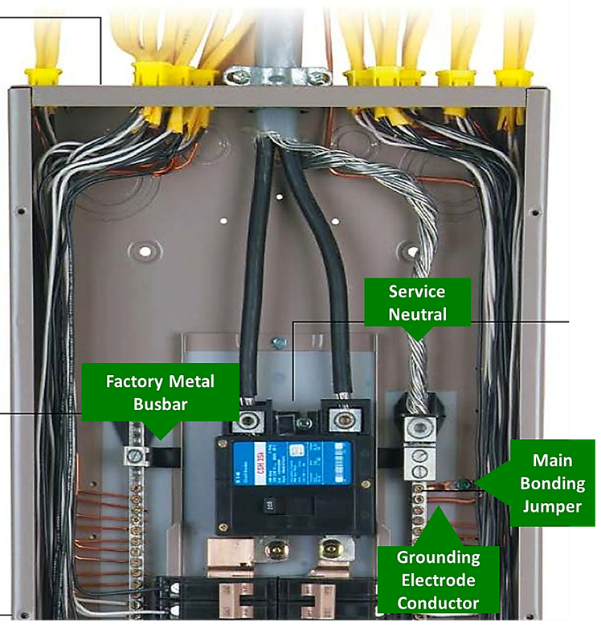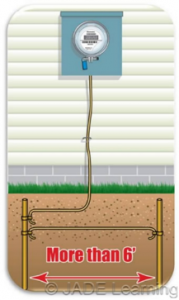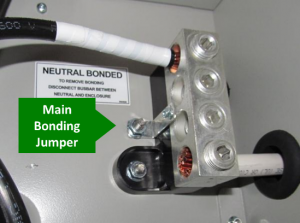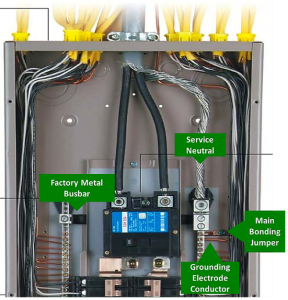The Grounded Conductor – New Informational Note Article 100 – 2020 NEC

By: Jerry Durham | Jun 30, 2020
In this 2020 Code cycle a new Informational Note now accompanies the term Grounded Conductor where it is defined in Article 100. The Note has been added to help electricians identify functional differences between Grounded and Grounding Conductors.
In defense of all who have struggled with these terms in the past, both grounded conductors and grounding conductors are in fact grounded. They just have different jobs.
Let’s now look at these two conductors – their similarities as well as their differences. Let’s look at the new Informational Note provided in the 2020 NEC and see if it aids the electrician in distinguishing between these two conductors.

The Grounded Conductor – Part I
Article 100 defines a Grounded Conductor as – A system or circuit conductor that is intentionally grounded.
This definition is undoubtedly correct, but as previously stated, a Grounding Conductor (aka Equipment Grounding Conductor) is ALSO grounded. Therefore, the definition provided for a Grounded Conductor does little to distinguish this conductor from an Equipment Grounding Conductor (EGC).
What about the new Informational Note in the 2020 NEC?
The new Informational Note states- Although an equipment grounding conductor is grounded, it is not considered a grounded conductor.
The new Informational Note reinforces for electricians that Grounding Conductors and Grounded Conductors are both grounded. And that in spite of this, Grounding Conductors are not considered Grounded Conductors by the NEC. But the Informational Note does little else in the way of shedding light on this topic.
To the NEC’s credit, the new Informational Note DOES alert the electrician that whenever they encounter the term “Grounded Conductor” in the Codebook they are NOT to interpret it to mean a bare or green-colored Equipment Grounding Conductor (EGC). And that is an important fact.
But it still does not answer the question – if both conductors are connected to ground, why isn’t an Equipment Grounding Conductor (EGC) considered a Grounded Conductor? What exactly is a Grounded Conductor beyond the definition provided in Article 100?
The Grounded Conductor – Part II
 Article 100 told us that a Grounded Conductor is a conductor that is intentionally grounded. This is true. The Grounded (white) Conductor in a branch circuit achieves continuity with ground through its connection with the Service Neutral Conductor in the main panel. The Service Neutral Conductor leaves the utility company transformer with the rest of the service drop and then enters the main panel. The Service Neutral Conductor is then connected by way of a Main Bonding Jumper (MBJ) to the metal enclosure of that main panel, which is then connected by a wire (Grounding Electrode Conductor) to earth.
Article 100 told us that a Grounded Conductor is a conductor that is intentionally grounded. This is true. The Grounded (white) Conductor in a branch circuit achieves continuity with ground through its connection with the Service Neutral Conductor in the main panel. The Service Neutral Conductor leaves the utility company transformer with the rest of the service drop and then enters the main panel. The Service Neutral Conductor is then connected by way of a Main Bonding Jumper (MBJ) to the metal enclosure of that main panel, which is then connected by a wire (Grounding Electrode Conductor) to earth.
The grounding electrode used for making a reliable connection with earth can be a copper water pipe, a ground ring, a concrete-encased electrode, or a driven ground such as a copper-coated 8 ft. ground rod; or a combination of these.
The Grounded Conductor – Part III
A Grounded Conductor is usually identified with the color white, although it can be gray. If the conductor is size 6 AWG or smaller, it must be solid in color or identified with three continuous stripes of color for the entire length of the conductor. If the Grounded Conductor is size 4 AWG or larger, Section 200.6 permits the conductor to be identified with white or gray only at the terminations.
The Grounded Conductor’s job is to serve as the return path for electrical current in a branch circuit, once that current passes through all loads in the circuit and is returning to its source. A Grounded Conductor according to the NEC is a current-carrying conductor. This is important because a bare or green-colored Equipment Grounding Conductor (EGC) is NOT considered a current-carrying conductor. And this is where the difference lies between these two conductors.
A Grounded Conductor (white or gray) and Equipment Grounding Conductor (bare or green) share these characteristics:
- They both are connected to the System Neutral Conductor at the main panel.
- They both are connected to the metal enclosure at the main panel (first means of disconnect.)
- They both are connected to earth.
- They both can carry electrical current.
The difference between these two conductor types is – the Grounded Conductor (white or gray) is designed to safely and continuously carry electrical current. The NEC even refers to a Grounded Conductor as a Current-Carrying Conductor.
On the other hand, an Equipment Grounding Conductor (bare or green) only carries current during a short-to-ground condition, when electrical current is briefly introduced onto normally non-current-carrying metal parts.
Equipment Grounding Conductor (EGC)
The Equipment Grounding Conductor (EGC), required by the NEC and permitted in the form of metal conduit, metal sheathing on metal-clad cable, or bare or green-colored wire-type conductors, is defined in Article 100 as follows:
Equipment Grounding Conductor (EGC) – A conductive path that is part of an effective ground-fault current path and connects normally non-current-carrying metal parts of equipment together and to the system grounded conductor (service neutral conductor) or to the grounding electrode conductor, or both.
So we see the Equipment Grounding Conductor (EGC) is NOT a current-carrying conductor according to the NEC, but is instead an effective ground-fault path that connects non-current-carrying metal parts, such as a metal panel box, a four-square metal box, or a metal stick of conduit to the Service Neutral Conductor, the Grounding Electrode Conductor (GEC), or both.
The Equipment Grounding Conductor (EGC) is designed to allow unwanted fault-current to travel back to its source by way of a low-impedance (unobstructed) electrical path.
This low-impedance path allows the current to quickly meet and exceed the rating of the overcurrent device protecting the circuit, so that circuit breaker or fuse will immediately trip and de-energize the exposed metal parts.
Equipment Grounding Conductors (EGC) Connected to the Service Neutral

On a final note, an observant electrician will wonder: Why is the Service Neutral Conductor attached to the metal enclosure of the first means of disconnect using a Main-Bonding-Jumper (MBJ)?
NEC 250.24 Requires a Main Bonding Jumper (MBJ)
The short answer is – Equipment Grounding Conductors (EGC) for branch circuits are terminated onto a terminal strip in direct contact with the metal panel box. When a short-to-ground occurs on an appliance (or other equipment) somewhere in a home or business, the shorted current rushes back to that metal panel box by way of the Equipment Grounding Conductor (EGC). When the current reaches that terminal strip and metal panel box, if the Service Neutral Conductor is NOT attached to that metal box, the fault current will try to make its way back to its source (the utility company transformer) by way of the Grounding Electrode (e.g. ground rod) driven in the earth. The earth is a poor conductor and current cannot move fast enough through the earth to trip an overcurrent device (under most circumstances.) Therefore, the metal that is not supposed to be energized may remain energized because current cannot ramp up fast enough to trip the 15-amp, 20-amp (or similar) circuit breaker protecting the circuit.
To prevent this, the Service Neutral Conductor that originates at the transformer is connected to the metal panel box through the Main-Bonding-Jumper (MBJ), and this offers a low-impedance path for fault-current to flow back to the transformer, thereby tripping the overcurrent device.
Ground rods are not installed to trip circuit breakers and fuses during a fault condition. Actually, they can’t trip these overcurrent devices under most conditions…But that is a topic for another day.

A Typical Main Breaker Electrical Panel with the Main Bonding Jumper (MBJ) Installed



Enjoyed reading this article.
Have a minor criticism, if you don’t mind.
When AC current flows in an electrical circuit, it flows (essentially) equally through all parts of the circuit at the same time. It does not “flow out to, then through the load, and then flows back to its source,” as you described, meaning that electrons are pushed by the applied voltage so all along the circuit electrons are compelled to move at the same time. And, with AC, a single electron coming from the source never has a chance to traverse the entire circuit before it has to turn around and move in the opposite direction. The individual electrons, the charge carriers, never get anywhere. Wild, but true.
An Ampere of current, as you know, is a “flow” of a large number of electrons across any cross-section of the circuit, for DC, but for AC the electrons “move slightly back and forth past any fixed cross section of the wire, without any gradual progression along the wire. In most alternating-current power circuits the current changes direction one hundred and twenty times a second. This is called a 60-cycle current.”
“the net flow is zero; that is, the flow in one direction along the wire equals the flow in the other direction” [Timbe and Bush, Principles of Electrical Engineering, Fourth Edition, John Wiley & Sons, New York, London, 1961]
There are a lot of half-assed guesses about AC electron flow posted around the internet, so you really need to be careful what you read. I know because I just did a quick Google search to update what came from my very old EE text. I found you a modern day calculation that says the same thing. See Paul Grimshaw’s Quora answer to the question “In a typical AC circuit, how far does each electron travel along the wire in one direction before the polarity is reversed in a single alternating cycle?”
He does a marvelous job calculating a copper wire circuit whose load is a 100 watt incandescent bulb, and he concludes “So all the electrons in the wire travel 0.28 microns. They then travel back again in the negative half cycle, by symmetry. No matter how long the bulb [100 watt incandescent light bulb] is lit, the electrons in the wire never move further than 0.28 microns from their starting point.”
That may seem way off topic, but I said it to help give your writing the clarity you hoped to achieve by writing the article in the first place. In a couple of places you had to mention the flow of AC current, and with this information you may find a better way to express that.
After all is said, would you propose better wording that would clarify the NEC, so that clarity can be distributed throughout the electrical world at the next revision? It’s a nice piece of work you did, my friend.